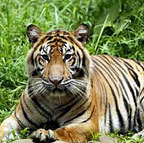| |
The ancient Chinese travel chronicles refer to a place
in the most southerly part of Sumatra called "Lamphung"
or "place of the southerly winds." Megalithic sculptures
discovered in Kebontebu, Kenali, Pugung and Batubedil also help
to date the province to Indonesia's greatest maritime empire, Sriwijaya.
Strategically located looking towards Krakatau and Java across the
Sunda Strait, Lampung has a long history of trade and is still an
important gateway into Sumatra, particularly from Jakarta.
The Province is generally flat with the highest mountains of Gunung
Pesagi, Tanggamas, Seminiung, Sekincau and Raya all being dormant
volcanoes. Bandar Lampung, the Provincial capital, was formerly
two separate towns, Tanjungkarang and the port of Telukbetung, which
after the infamous eruption of Krakatau were both completely covered
in volcanic ash. In the course of development, however, these towns
have merged together to become one single city, which is rapidly
developing. Being blessed with incredibly fertile soil, agriculture
has naturally become the main industry of the province. Clove, coffee
and coconut plantations are abundant along the southern coast while
pepper, coffee, cassava, cocoa and rice are preferred in the eastern
sections of the region. The area around Lake Ranu in the northern
part of Lampung, however, is a primary tobacco growing area.
The Way Kambas nature reserve in the west of the province
is a perfect place to see Sumatran elephants being trained to work
in thick tropical jungles as well as hundreds of species of exotic
birds. Tigers still roam this land although they are rare. The largest
flower in the world, Rafflesia, can be seen at the Bukit Barisan
Selatan National Park.
|














